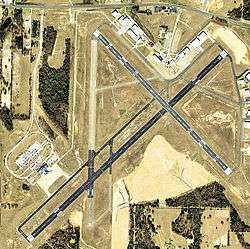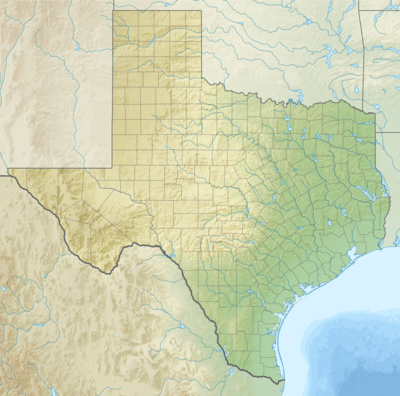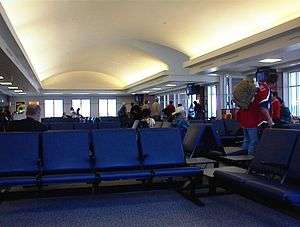Tyler Pounds Regional Airport
| Tyler Pounds Regional Airport (former Pounds Army Airfield) | |||||||||||||||||||
|---|---|---|---|---|---|---|---|---|---|---|---|---|---|---|---|---|---|---|---|
 USGS 2006 orthophoto | |||||||||||||||||||
| Summary | |||||||||||||||||||
| Airport type | Public | ||||||||||||||||||
| Owner | City of Tyler | ||||||||||||||||||
| Serves | Tyler, Texas | ||||||||||||||||||
| Elevation AMSL | 544 ft / 166 m | ||||||||||||||||||
| Coordinates | 32°21′14″N 095°24′10″W / 32.35389°N 95.40278°WCoordinates: 32°21′14″N 095°24′10″W / 32.35389°N 95.40278°W | ||||||||||||||||||
| Website | www.cityoftyler.org/ | ||||||||||||||||||
| Map | |||||||||||||||||||
 TYR Location | |||||||||||||||||||
| Runways | |||||||||||||||||||
| |||||||||||||||||||
| Statistics (2011) | |||||||||||||||||||
| |||||||||||||||||||

Tyler Pounds Regional Airport (IATA: TYR, ICAO: KTYR, FAA LID: TYR) is a city-owned airport three miles west of Tyler, in Smith County, Texas, United States.[1]
The National Plan of Integrated Airport Systems for 2011–2015 called it a primary commercial service airport.[2] Federal Aviation Administration records show 76,168 passenger boardings (enplanements) in calendar year 2008,[3] 73,841 in 2009 and 74,357 in 2010.[4]
The airport has been expanding to meet goals in "The Tyler Master Plan"; in August 17, 2002, the airport opened a new terminal building, doubling its space. Tyler is a large center for General Aviation, with three public parking lots for General Aviation arrivals.
History
- see: Pounds Army Airfield for its World War II use
The airport opened in November 1929 as Tyler Municipal Airport. During World War II the airfield was used by the United States Army Air Forces as a training base and renamed Pounds Field after Lieutenant Jack Windham Pounds. At the end of the war the airfield was turned over to local government for civil use and became Tyler Pounds Regional Airport.[5][6][7][8]
Historical airline service
Scheduled passenger airline service began during the 1930s. Tyler was listed in Delta Air Lines timetables by 1936 as part of a Dallas-Atlanta route flown via Shreveport and other intermediate stops in Alabama, Georgia, Louisiana, Mississippi and Texas. During the 1940s and early 1950s this service was operated with Douglas DC-3 prop aircraft. In 1952, DC-3 service operated daily by Delta included an eastbound routing of Fort Worth - Dallas - Tyler - Longview - Shreveport - Monroe - Jackson - Meridian - Selma - Montgomery - Columbus - Atlanta and a westbound routing of Atlanta - Columbus - Montgomery - Meridian - Hattiesburg - New Orleans - Baton Rouge - Alexandria - Shreveport - Tyler - Dallas - Fort Worth.[9] Also in 1952, Delta had competition on its nonstop route to Dallas Love Field (DAL) as Trans-Texas Airways (TTa) was operating nonstop flights as well with each airline operating three flights a day with both air carriers operating DC-3 aircraft on the route.[10] By 1958 Delta had ended its service to Tyler and with the airport no longer being listed in its timetables. In 1936, Braniff Airways offered connections to Tyler via Delta's service; however, this airline's timetables show no evidence that Braniff ever actually served Tyler.
Trans-Texas Airways (TTa) began serving Tyler during the 1940s as part of a Douglas DC-3 route between Dallas Love Field (DAL), Beaumont/Port Arthur (BPT) and Houston Hobby Airport (HOU). In 1952, TTa was operating three DC-3 flights a day to Beaumont/Port Arthur via intermediate stops in Lufkin, Palestine and Nacogdoches in east Texas with one of these flights continuing on to Galveston and Houston.[11] Service was eventually upgraded to Convair 240 prop aircraft and then Convair 600 turboprops. In 1966, TTa was operating nonstop Convair 240 and DC-3 flights to Dallas as well as direct, no change of plane Convair 240 service to Houston and New Orleans.[12] By 1968, the turbine age had arrived at the airport as TTa had introduced Convair 600 turboprop service although the airline was also continuing to serve Tyler with DC-3 aircraft at this time.[13]
Trans-Texas subsequently changed its name to Texas International Airlines (TI) which in turn was serving Tyler in 1970 with Convair 600 turboprops and smaller Beechcraft 99 commuter turboprops on nonstop flights to Dallas/Fort Worth International Airport (DFW) with direct, no change of plane Convair 600 service being flown to Memphis and New Orleans.[14] In 1974, TI was operating all of its service into Tyler with Convair 600 turboprops with three nonstop flights every weekday to Dallas/Fort Worth with direct, no change of plane service being operated to Houston and Memphis.[15] By 1975, Texas International had competition on the Tyler-Dallas/Fort Worth route as commuter air carrier Metroflight Airlines, a subsidiary of Metro Airlines, was operating seven nonstop flights to DFW every weekday with de Havilland Canada DHC-6 Twin Otter turboprops while TI was operating two nonstop flights on weekdays with Convair 600 turboprops.[16] According to the February 1, 1976 edition of the Official Airline Guide, Texas International was operating direct, no change of plane service to Tyler with Convair 600 aircraft from Austin (AUS), Houston (IAH), Midland/Odessa (MAF), Shreveport (SHV) and Wichita Falls (SPS) in addition to its nonstop CV-600 service from Dallas/Fort Worth and Longview with a total of four flights a day being operated into the airport on weekdays.[17] This same OAG lists nineteen flights being operated every weekday by Metroflight with Twin Otter aircraft into Tyler with nine nonstop flights from Dallas/Fort Worth (DFW), nine nonstop flights from Longview (GGG) and one nonstop flight from Nacogdoches (OCH) with this latter flight also providing direct service from Houston (IAH) and Lufkin (LFK).[18]
By 1978, Texas International had ended its turboprop service to Tyler.[19] TI subsequently became an all-jet airline operating a fleet of DC-9 twin jets before eventually merging with Continental Airlines.
In 1979, Metroflight Airlines was operating the only air service to Dallas/Fort Worth (DFW) from the airport with nonstop flights operated with de Havilland Canada DHC-6 Twin Otter and Short 330 turboprop aircraft as well as flying direct, no change of plane Twin Otter service to Houston Intercontinental Airport (IAH) via Longview and/or Nacogdoches.[20][21] By 1981, the airline was operating twelve round trip flights every weekday nonstop between Tyler and Dallas/Fort Worth with Short 330 and Twin Otter turboprops.[22] Metroflight then became an American Eagle air carrier operating code sharing flights on behalf of American Airlines and in 1985 was continuing to operate Twin Otter service between the airport and the American hub at Dallas/Fort Worth International Airport.[23] Also in 1985, Air Spirit, a commuter air carrier, was operating nonstop flights to Austin with Embraer EMB-110 Bandeirante turboprop aircraft as part of a Texarkana - Tyler - Austin route.[24]
In 1989, competition had once again resumed on the Tyler-Dallas/Fort Worth (DFW) route as two airlines were operating nonstop service between the airport and DFW: American Eagle flying Saab 340 turboprops and Delta Connection operated by Atlantic Southeast Airlines (ASA) flying Embraer EMB-110 Bandeirante turboprop service via a code sharing aqreement on behalf of Delta Air Lines which was operating a hub at DFW at the time in competition with American.[25] According to the Official Airline Guide (OAG), both airlines were operating a combined total of fourteen round trip flights every weekday between the airport and DFW at this time. By 1991, Delta Connection operated by ASA was flying larger Embraer EMB-120 Brasilia propjets on the TYR-DFW route in addition to its EMB-110 Bandeirante turboprops.[26]
In 1995, Continental Express was operating Embraer EMB-120 Brasilia propjet service to Houston Intercontinental Airport (IAH) with three nonstop flights every weekday via a code sharing agreement on behalf of Continental Airlines.[27] By 1999, Continental Express had replaced this EMB-120 Brasilia service between Tyler and IAH with smaller Beechcraft 1900D commuter turboprop aircraft operating four nonstop flights every weekday.[28]
Also during the mid 1990s, Conquest Airlines, a commuter air carrier, was operating nonstop service to both Austin (AUS) and San Antonio (SAT) with Fairchild Swearingen Metroliner propjets.[29] By 2000, Austin Express, also a commuter air carrier, had replaced Conquest with nonstop service to Austin (AUS) operated with Metroliner propjets.[30]
Museum
.jpg)
The Historic Aviation Memorial Museum (HAMM), an aviation museum located at the airport, rented and moved into the former Tyler passenger terminal that had been closed since 2002. The museum has a number of military jet fighter aircraft on display among other exhibits and also flies and maintains two Russian-manufactured Mig 17F jet fighters which are based at the airport.[31]
Facilities
The airport covers 1,200 acres (486 ha) at an elevation of 544 feet (166 m). It has three asphalt runways: 4/22 is 7,802 by 150 feet (2,378 x 46 m); 13/31 is 5,200 by 150 feet (1,585 x 46 m); 17/35 is 4,832 by 150 feet (1,473 x 46 m).[1]
In the year ending July 31, 2011 the airport had 48,677 aircraft operations, average 133 per day: 83% general aviation, 14% air taxi, 2% airline, and 1% military. 152 aircraft were then based at the airport: 60% single-engine, 22% jet, 16% multi-engine, and 2% helicopter.[1]
Airline and destination
Passenger
| Airlines | Destinations |
|---|---|
| American Eagle | Dallas/Fort Worth |
Accidents and incidents
- July 13, 2017: Piper PA-31T Cheyenne Owned by T-210 HOLDINGS LLC[32]: Aircraft went down as it was leaving the airport, headed to Midland Airpark. The aircraft crashed a quarter-mile south of the airport. There were two fatalities.[33][34]
References
- 1 2 3 4 FAA Airport Master Record for TYR (Form 5010 PDF). Federal Aviation Administration. Effective November 15, 2012.
- ↑ "2011–2015 NPIAS Report, Appendix A" (PDF, 2.03 MB). faa.gov. Federal Aviation Administration. October 4, 2010.
- ↑ "Enplanements for CY 2008" (PDF, 1.0 MB). faa.gov. Federal Aviation Administration. December 18, 2009.
- ↑ "Enplanements for CY 2010" (PDF, 189 KB). faa.gov. Federal Aviation Administration. October 4, 2011.
- ↑

- ↑ Shaw, Frederick J. (2004), Locating Air Force Base Sites History’s Legacy, Air Force History and Museums Program, United States Air Force, Washington DC, 2004.
- ↑ Manning, Thomas A. (2005), History of Air Education and Training Command, 1942–2002. Office of History and Research, Headquarters, AETC, Randolph AFB, Texas ASIN: B000NYX3PC
- ↑ Thole, Lou (1999), Forgotten Fields of America : World War II Bases and Training, Then and Now - Vol. 2. Publisher: Pictorial Histories Pub, ISBN 1-57510-051-7
- ↑ http://www.timetableimages.com, Aug. 1, 1952 Delta Air Lines system timetable
- ↑ http://www.timetableimages.com, Aug. 1, 1952 Delta Air Lines system timetable & Jan. 1, 1952 Trans-Texas Airways system timetable
- ↑ http://www.timetableimages.com, Jan. 1, 1952 Trans-Texas Airways system timetable
- ↑ http://www.timetableimages.com, Oct. 30, 1966 Trans-Texas Airways system timetable
- ↑ http://www.timetableimages.com, Aug. 1968 Trans-Texas Airways system timetable
- ↑ http://www.departedflights.com, July 1, 1970 Texas International Airlines system timetable
- ↑ http://www.timetableimages.com, March 1, 1974 Texas International Airlines system timetable
- ↑ http://www.departedflights.com, April 15, 1975 Official Airline Guide (OAG), Dallas/Fort Worth-Tyler flight schedules
- ↑ Feb. 1, 1976 Official Airline Guide (OAG), Tyler flight schedules
- ↑ Feb. 1, 1976 Official Airline Guide (OAG), Tyler flight schedules
- ↑ http://www.departedflights.com, March 15, 1978 Texas International Airlines system timetable
- ↑ http://www.departedflights.com, Nov. 15, 1979 Official Airline Guide (OAG), Dallas/Fort Worth-Tyler flight schedules
- ↑ http://www.departedflights.com, Nov. 15, 1979 Metroflight Airlines route map
- ↑ http://www.departedflights.com, April 1, 1981 Official Airline Guide (OAG), Dallas/Fort Worth-Tyler flight schedules
- ↑ http://www.departedflights.com, Feb. 15, 1985 Official Airline Guide (OAG), Dallas/Fort Worth-Tyler flight schedules
- ↑ http://www.departedflights.com, Feb. 15, 1985 Air Spirit route map & Feb. 15, 1985 Official Airline Guide (OAG), Austin flight schedules
- ↑ http://www.departedflights.com, Dec. 15, 1989 Official Airline Guide (OAG), Dallas/Fort Worth-Tyler flight schedules
- ↑ http://www.departedflights.com, Oct. 1, 1991 Official Airline Guide (OAG), Dallas/Fort Worth-Tyler flight schedules
- ↑ http://www.departedflights.com, April 2 1995 Official Airline Guide (OAG), Houston Intercontinental-Tyler flight schedules
- ↑ http://www.departedflights.com, June 1, 1999 Official Airline Guide (OAG), Houston Intercontinental-Tyler flight schedules
- ↑ http://www.departedflights.com, Sept. 15, 1994 & Sept. 30, 1996 Conquest Airlines route maps
- ↑ http://www.timetableimages.com, March 18, 2000 Austin Express system timetable
- ↑ http://www.tylerhamm.com/exhibits.html
- ↑ "Flight Activity History (N47GW)". FlightAware. Retrieved July 14, 2017.
- ↑ "Family: Pastor killed in plane crash near Tyler airport". KLTV. July 13, 2017. Retrieved July 14, 2017.
- ↑ "FAA Accident and Incident Notification(s): Notice(s) Created 13-JUL-17". US Department of Transportation: Federal Aviation Administration. July 13, 2017. Retrieved July 14, 2017.
External links
| Wikimedia Commons has media related to Tyler Pounds Regional Airport. |
- Tyler Pounds Regional Airport at City of Tyler website
- Historic Aviation Memorial Museum, official website
- Tyler Pounds Regional (TYR) at Texas DOT airport directory
- Aerial image as of January 1996 from USGS The National Map
- FAA Airport Diagram (PDF), effective October 11, 2018
- FAA Terminal Procedures for TYR, effective October 11, 2018
- Resources for this airport:
- AirNav airport information for KTYR
- ASN accident history for TYR
- FlightAware airport information and live flight tracker
- NOAA/NWS latest weather observations
- SkyVector aeronautical chart for KTYR
- FAA current TYR delay information